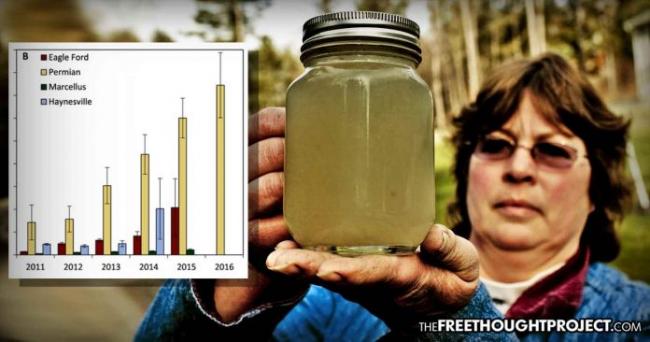Articles Menu

A Duke University study says the fracking industry is sucking up the nation's drinkable water and replacing it with toxic waste.
Hydraulic fracturing is a natural gas extraction method that has become extremely controversial for its environmental impacts. Fracking is the process of drilling down into the earth before a high-pressure water mixture is directed at the rock to release the gas inside. Water, sand, and chemicals are injected into the rock at high pressure, which allows the gas to flow out to the head of the well. Wastewater produced from this process is highly toxic and filled with a variety of chemicals.
In many cases, people who live near fracking sites have been able to set fire to the water and air that comes through their pipes. It has also been found to contaminate drinking water. Unfortunately, fracking is still somewhat popular publicly because people know very little about it and it is also popular politically because all of the politicians have a hand in it.
Due to an increased prevalence of seismic activity in the vicinity of fracking areas, many activists have pointed out that this process may cause earthquakes as well.
The abstract of the study reads:
UNCONVENTIONAL OIL AND GAS EXPLORATION IN THE UNITED STATES HAS EXPERIENCED A PERIOD OF RAPID GROWTH, FOLLOWED BY SEVERAL YEARS OF LIMITED PRODUCTION DUE TO FALLING AND LOW NATURAL GAS AND OIL PRICES. THROUGHOUT THIS TRANSITION, THE WATER USE FOR HYDRAULIC FRACTURING AND WASTEWATER PRODUCTION IN MAJOR SHALE GAS AND OIL PRODUCTION REGIONS HAS INCREASED; FROM 2011 TO 2016, THE WATER USE PER WELL INCREASED UP TO 770%, WHILE FLOWBACK AND PRODUCED WATER VOLUMES GENERATED WITHIN THE FIRST YEAR OF PRODUCTION INCREASED UP TO 1440%. THE WATER-USE INTENSITY (THAT IS, NORMALIZED TO THE ENERGY PRODUCTION) INCREASED UBIQUITOUSLY IN ALL U.S. SHALE BASINS DURING THIS TRANSITION PERIOD. THE STEADY INCREASE OF THE WATER FOOTPRINT OF HYDRAULIC FRACTURING WITH TIME IMPLIES THAT FUTURE UNCONVENTIONAL OIL AND GAS OPERATIONS WILL REQUIRE LARGER VOLUMES OF WATER FOR HYDRAULIC FRACTURING, WHICH WILL RESULT IN LARGER PRODUCED OIL AND GAS WASTEWATER VOLUMES.
Fracking is especially harmful to water supplies because the water is nearly impossible to treat after exposed to the chemicals, meaning it could be lost to the world permanently.
“In addition, the water used for hydraulic fracturing is retained within the shale formation; only a small fraction of the fresh water injected into the ground returns as flowback water, while the greater volume of FP water returning to the surface is highly saline, is difficult to treat, and is often disposed through deep-injection wells. This means that despite lower water intensity compared to other energy resources, the permanent loss of water use for hydraulic fracturing from the hydrosphere could outweigh its relatively lower water intensity,” the study says.
Avner Vengosh, professor of geochemistry and water quality at Duke’s Nicholas School of the Environment, and co-author of the study, said that this study encompassed many years of data collected about fracking.
“Previous studies suggested hydraulic fracturing does not use significantly more water than other energy sources, but those findings were based only on aggregated data from the early years of fracking. After more than a decade of fracking operation, we now have more years of data to draw upon from multiple verifiable sources. We clearly see a steady annual increase in hydraulic fracturing’s water footprint, with 2014 and 2015 marking a turning point where water use and the generation of flowback and produced water began to increase at significantly higher rates,” Vengosh told Phys.org.
As The Free Thought Project has reported in the past, whistleblower scientists have come forward to say that they were threatened and told to keep silent about the possible dangers that fracking has to drinking water and the environment.
Just last week, the Southwest Pennsylvania Environmental Health Project (EHP) and published a study showing that fracking in the state is done dangerously close to homes and businesses.